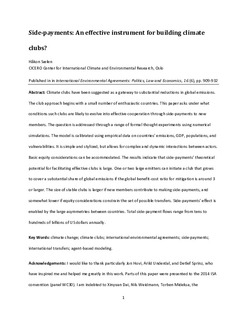| dc.contributor.author | Sælen, Håkon | |
| dc.date.accessioned | 2018-01-15T15:54:17Z | |
| dc.date.available | 2018-01-15T15:54:17Z | |
| dc.date.created | 2015-11-17T16:31:27Z | |
| dc.date.issued | 2015 | |
| dc.identifier.citation | International Environmental Agreements: Politics, Law and Economics. 2015, . | nb_NO |
| dc.identifier.issn | 1567-9764 | |
| dc.identifier.uri | http://hdl.handle.net/11250/2477648 | |
| dc.description | This is a post-peer-review, pre-copyedit version of an article published in International Environmental Agreements: Politics, Law and Economics. The final authenticated version is available online at: https://doi.org/10.1007/s10784-015-9311-8 | nb_NO |
| dc.description.abstract | Climate clubs have been suggested as a gateway to substantial reductions in global emissions. The club approach begins with a small number of enthusiastic countries. This paper asks under what conditions such clubs are likely to evolve into effective cooperation through side-payments to new members. The question is addressed through a range of formal thought experiments using numerical simulations. The model is calibrated using empirical data on countries’ emissions, GDP, populations, and vulnerabilities. It is simple and stylized, but allows for complex and dynamic interactions between actors. Basic equity considerations can be accommodated. The results indicate that side-payments’ theoretical potential for facilitating effective clubs is large. One or two large emitters can initiate a club that grows to cover a substantial share of global emissions if the global benefit–cost ratio for mitigation is around 3 or larger. The size of stable clubs is larger if new members contribute to making side-payments, and somewhat lower if equity considerations constrain the set of possible transfers. Side-payments’ effect is enabled by the large asymmetries between countries. Total side-payment flows range from tens to hundreds of billions of US dollars annually. | nb_NO |
| dc.language.iso | eng | nb_NO |
| dc.title | Side-payments: an effective instrument for building climate clubs? | nb_NO |
| dc.type | Journal article | nb_NO |
| dc.type | Peer reviewed | nb_NO |
| dc.description.version | acceptedVersion | nb_NO |
| dc.source.pagenumber | 24 | nb_NO |
| dc.source.journal | International Environmental Agreements: Politics, Law and Economics | nb_NO |
| dc.identifier.doi | 10.1007/s10784-015-9311-8 | |
| dc.identifier.cristin | 1290106 | |
| dc.relation.project | Norges forskningsråd: 209701 | nb_NO |
| cristin.unitcode | 7475,0,0,0 | |
| cristin.unitname | CICERO Senter for klimaforskning | |
| cristin.ispublished | true | |
| cristin.fulltext | postprint | |
| cristin.qualitycode | 1 | |
